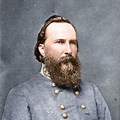Pictured is Confederate General James Longstreet.
The civil war ended 158 years, 7 months, and 4 days ago. We must continue to study and learn and talk about it, but the arguing must end.
Unfortunately, it is not hard to find people still willing to argue about the war and its causes. Some people will belligerently assert that the war had nothing at all to do with slavery; while in other circles that may or may not include my wife, you will face derisive indignation if you dare to suggest that slavery may not have been the only cause of the war.
Every time a Civil War monument is removed, or recontextualized there will be two competing protests, and those protests sometimes turn violent.
Proposed: Let’s stop arguing about the Civil War and start accepting the available lessons to be learned.
Did you know that Robert E. Lee opposed the building of monuments and memorials? He thought it would be wiser “not to keep open the sores of war”, and he advocated peace and reconciliation.
It is also worth considering the post-war efforts of General Lee’s second in command, James Longstreet, about whom a biography has recently been published. The book is called The Confederate General who defied the South. I have not read it, but I have read some excerpts and highlights in an article from The Atlantic. According to the article, Longstreet took an even more active role in post-war reconstruction and reconciliation. Yes, Longstreet was a slave owner before the war, but he worked for civil rights after. The South had he said, “appealed to the arbitrament of the sword,” and had a moral obligation to accept the outcome: “The decision,” he wrote, “was in favor of the North, so her construction becomes the law.”
The author of the article in The Atlantic, Eric Froner, mentioned a trip in 1997 to Gettysburg National Military Park, when funds were being raised to erect a statue of Longstreet at the battlefield. At that time, Longstreet’s efforts towards building a new South were still considered by some to be a problem. The Sons of Confederate Veterans who commissioned the statue said the general was being honored for his “war service,” not his “postwar activities.” To me, the bright spot in General Longstreet’s resume is his post-war efforts and not the other way around.


I argue that the Civil War is misnamed, it was a war of secession and forced reunion.
George Mason, slave owner and Virginia statesman wrote in 1773, “[Slavery is] that slow Poison, which is daily contaminating the Minds & Morals of our People.” As a delegate to the 1787 Constitutional Convention, he objected to the twenty-year allowance to continue the importation of slaves, and lack of a bill of rights in the final draft. He wanted a federal government to inhibit state and local governments from suppressing liberty.
In 1787 Congress prohibited slavery in the Northwest Territories. In 1799 George Washington, ever mindful of the precedents he set, died and willed his slaves to be emancipated after the death of his widow.
Congress made slave importation illegal in 1807. Democrats won pro-slavery gains with the Kansas-Nebraska Act, the Missouri Compromise, and the Dred Scott Supreme Court decision.
The Republican Party was founded in 1854 by anti-slavery activists. Secession was a response to the results of the 1860 federal election where Republicans won the presidency and both houses of Congress.
The North prosecuted the war for two years with tens of thousands of volunteers before the first draft. An estimated 620,000 soldiers from both sides died and 2 million were injured.
After the war, southern Democrats imposed segregation. When the federal government, in the spirit of George Mason, ruled that state and local governments could no longer force segregation, Democrats put Confederate battle symbols on their state flags, erected monuments at taxpayer expense, and named schools for Confederate leaders.
Democrat presidents and congresses expanded payroll taxes, huge subsidies, intrusive rules, and massive debt that make workers and employers involuntary servants of a government that takes its share from the top and forces future earners to pay the debt.
Moderate Republicans have only slowed it down. The feeble Republican Party is still the party of emancipation.
Richard: You said, “I argue that the Civil War is misnamed, it was a war of secession and forced reunion.” How would feel about calling it Secession by Force of Arms, because it surely was that!
Thank you for your astute historical analysis!
As to your last two paragraphs, you said, “Democrat presidents and congresses expanded payroll taxes, huge subsidies, intrusive rules, and massive debt that make workers and employers involuntary servants of a government that takes its share from the top and forces future earners to pay the debt.” And “Moderate Republicans have only slowed it down. The feeble Republican Party is still the party of emancipation.”
Thanks also for taking the Long View of Republicanism. If it wasn’t for so many short-term obstacles getting in the way, I am sure we would all be much better off than we are.